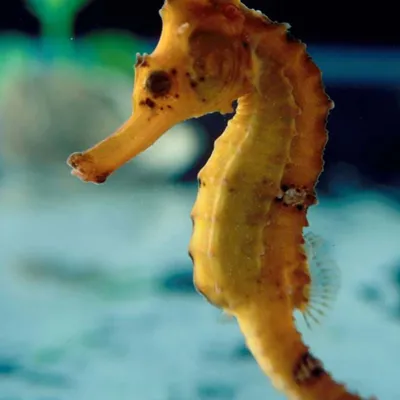
Playful Little Creatures
A unique feature exhibit at the SEA LIFE Orlando aquarium is the seahorses. Learn a load of interesting facts about these magical creatures, which get their name from the Greek word "Hippocampus," meaning seahorse monster.
Seahorse Facts
There are so many fascinating facts about seahorses to explore - did you know that their tail resembles a monkey's? Or that the seahorse was named after its head, which resembles that of a horse?
Despite their land mammal name-sake, all seahorses live in the sea - typically in seagrass beds and coral reefs. The seahorse is found in shallow, temperate - tropical waters. You might also find some seahorse species in estuaries, including short-snouted seahorses.
Seahorses usually eat small crustaceans, eating 30 to 50 times a day if they can. Interestingly, the seahorse doesn’t have teeth, or a stomach, so they eat by sucking crustaceans through their snout and into their digestive system.
Yes, they do! One of the most famous facts about seahorses is that the males brood the babies.
A male seahorse has a special brooding pouch on its belly where the female can place her eggs. After just a few weeks, the babies are ready to enter the world, and the male seahorse gives birth. To do this, he’ll rock back and forth like a rocking horse while the tiny babies shoot out from a small hole in his belly.
Visit us, and you never know; you might be in luck and witness this rare experience of the male seahorse giving birth!
Most seahorses are monogamous and will often mate for life. Staying with just one mate allows them more pregnancies during mating season, meaning a more productive reproduction!
Yes, a seahorse is a very small fish, and it is only named a 'horse' after its horse-like head shape. The seahorse is part of the Syngnathidae family, which also includes pipefishes and seadragons. There are at least 50 different types of seahorse species, and they come in a range of sizes, shapes, and colors.
Types of Seahorses
There are so many different types of seahorses to explore. Here are just a few species that show you how much they can differ:
- Bigbelly /Pot-Bellied Seahorse (Hippocampus abdominalis) - Known for its big belly, this is one of the largest seahorse species. They’re typically found in Australia and New Zealand and can grow up to 35 cm.
- Dwarf Seahorse (Hippocampus zosterae) - One of the smallest seahorse species in the world, found in the Gulf of Mexico. This seahorse can grow up to 2.5 cm.
- Zebra Seahorse (Hippocampus zebra) - Striped black and white like a zebra, this seahorse is found in Australia. It can grow up to 9.4 cm.
- Sindo’s Seahorse (Hippocampus sindonis) - A vibrant, spiky seahorse also known as the “painted seahorse”. This species can be found in Japan and can grow up to 8 cm.
- Knysna Seahorse (Hippocampus capensis) - One of the rarest seahorses in the world, the knysna can range from a purple-black to pale green color. It’s South Africa’s only endemic seahorse, and grows up to 12 cm.
Seahorses at SEA LIFE
Want to come face-to-tail with a real seahorse? You can at SEA LIFE Orlando! Come and meet our seahorses at the Seahorse Temple, just after our 360° Tunnel. Find it on our aquarium map.
There are 9 interactive zones to explore at SEA LIFE Orlando. Discover what’s inside.